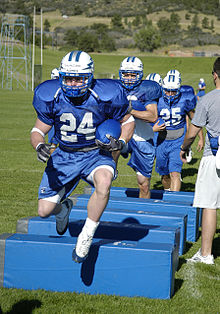Training (sport)

In the field of sport, training is regular physical exercise (stress) for the purpose of increasing performance or maintaining athletic performance on the basis of growth processes. The training in competitive sports very different from training in amateur sports .
Competitive sport and popular sport
In competitive sports , training is tailored to the type of sport and is individually tailored to the athlete . It is a complex and planned effect on the performance status, mostly under the guidance and control of trainers and with the aim of being able to present the best possible performance in probation situations. Essential components of training in competitive sports are various types of fitness training and sport-specific technical training to improve muscular coordination .
In competitive sports, training is a complex process because various performance-relevant characteristics of the athlete can be systematically influenced with long-term planning. Training content, training methods, training structure and training organization must be planned over a longer period of time. This includes, for example, the definition of sub-goals, differentiated performance reviews and the comparison of training-scientific findings with the respective results of the training. Depending on the training goal, the athlete's performance level should be increased or maintained or reduced (when training off).
In popular sport, the focus is on improving or maintaining general physical performance ( fitness ). In this area, athletic training can usually be equated with fitness training . In popular sport, it is mainly about avoiding a lack of exercise, preventing damage to health and enjoying physical activity, possibly also about social contacts when training in groups.
There are fuzzy boundaries between the two areas. Various sports with sport-specific training are also practiced in popular sports. Ambitious amateur athletes work similarly to top athletes with sophisticated training plans and try to systematically optimize their performance, some also take part in competitions.
Training types (selection)
- General athletics - for example in endurance sports to improve general mobility and the posture system
-
Endurance training - serves the ability to maintain performance at a high level over a long period of time by economizing the metabolism, improving metabolism and the cardiovascular system. Variants:
- Basic endurance training
- Strength endurance training
- Speed endurance training
- Interval training
- Training intramuscular coordination
- Hypertrophy training - increases the thickness of muscle fibers and is used in bodybuilding.
- Strength training - strengthens muscle strength, mostly with weights and strength machines
- Speed strength training
- Agility training
- Differential training - motor errors are compensated for
- Intermittent training - combination of endurance and speed strength training
- High Intensity Training - short and very hard training units
- Training - for competitive athletes, the scheduled return of performance to a lower level, for example at the end of the season
functionality
The load (training stimulus) leads to a disruption of the biochemical balance in the organism ( homeostasis disorder ). In order to be better prepared for future stresses of the same kind, the body reacts to this with an adaptation that results in a higher functional level. An example of this is the supercompensation of glycogen stores in the stressed muscles after endurance exercise.
In order to control the training correctly, i.e. to set sufficient stress stimuli for an adaptation, but not to overload the organism, precise knowledge of the stress of individual training units or their sum is required. The training load is determined by the so-called load norms.
Periodization and cycling of training
In the periodization of sports training , certain training sections ( period cycles ), which are repeated in their content form in the training year, are divided into preparation period , competition period and transition period . Preparation, competition and transition periods are often divided into stages. The periodization enables a framework planning of the performance development in sports training. In order to make the transitions smoother, a system of block training has become established, which in this context is usually called block periodization .
When cycling sports training, it is divided into so-called macro cycles . The macro cycle (often lasting half a year) is divided into several mesocycles and can be repeated in terms of content and stress.
The mesocycle consists of several micro-cycles , has various tasks (e.g. improving specific performance) to develop performance in the macro-cycle, and its tasks are repeated in the training process. The mesocycle corresponds to the anabolic steroids administration cycle.
The micro cycle is the short-term training cycle, usually extends over periods of one week and is repeated in the training process. This can also be done immediately after the first one.
See also
literature
- M. Letzelter: Training basics . Rowohlt, Reinbek 1987.
- D. Martin, K. Carl, K. Lehnertz: Manual training theory . Hofmann, Schorndorf 1991.
- Jürgen Weineck: Optimal training. Performance physiological training with a special focus on children and youth training. 16th edition. Spitta, Balingen 2009, ISBN 978-3-938509-96-8 .
- P. Röthig (Ed.) U. a .: Sports science lexicon . Hofmann, Schorndorf 2003.
- G. Schnabel, D. Harre, A. Borde (Ed.): Training science . Sports publishing house, Berlin 1998.
Web links
Individual evidence
- ↑ dr-moosburger.at ( Memento of the original from April 23, 2014 in the Internet Archive ) Info: The archive link was inserted automatically and has not yet been checked. Please check the original and archive link according to the instructions and then remove this notice.
- ↑ See Röthig et al. 1992, p. 519 f.
- ↑ Arnd Krüger : How does block periodization work? Learning Curves and Super Compensation Curves: Special Features of Block Periodization. FdSnow. Specialized journal for skiing 32 (2014), 2, 22–33.
- ^ Juan Manuel García Manso: La fuerza fundamentación, valoración y entrenamiento. Gymnos, Madrid 2002, ISBN 84-8013-215-9 .